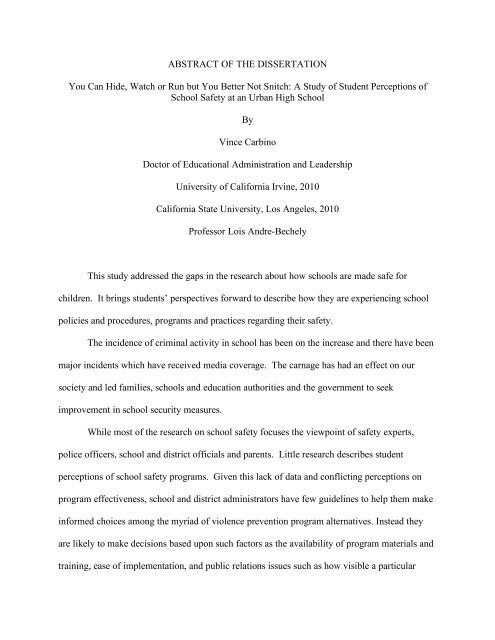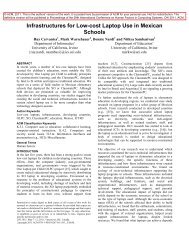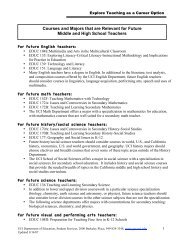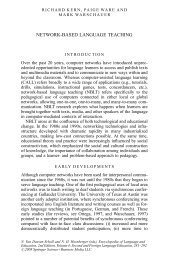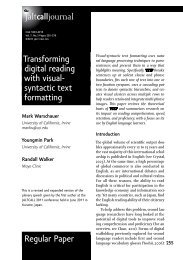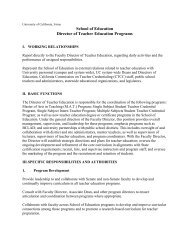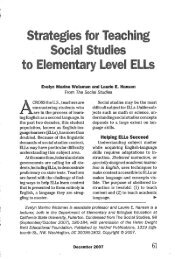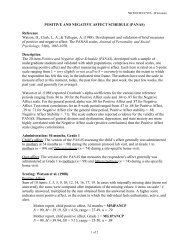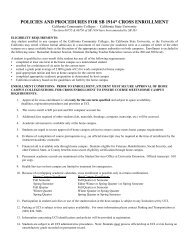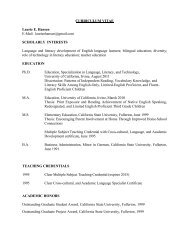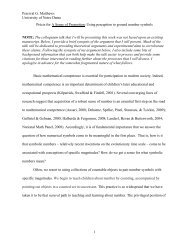ACSA ABSTRACT OF THE DISSERTATION V. Carbino-1
ACSA ABSTRACT OF THE DISSERTATION V. Carbino-1
ACSA ABSTRACT OF THE DISSERTATION V. Carbino-1
You also want an ePaper? Increase the reach of your titles
YUMPU automatically turns print PDFs into web optimized ePapers that Google loves.
<strong>ABSTRACT</strong> <strong>OF</strong> <strong>THE</strong> <strong>DISSERTATION</strong><br />
You Can Hide, Watch or Run but You Better Not Snitch: A Study of Student Perceptions of<br />
School Safety at an Urban High School<br />
By<br />
Vince <strong>Carbino</strong><br />
Doctor of Educational Administration and Leadership<br />
University of California Irvine, 2010<br />
California State University, Los Angeles, 2010<br />
Professor Lois Andre-Bechely<br />
This study addressed the gaps in the research about how schools are made safe for<br />
children. It brings students’ perspectives forward to describe how they are experiencing school<br />
policies and procedures, programs and practices regarding their safety.<br />
The incidence of criminal activity in school has been on the increase and there have been<br />
major incidents which have received media coverage. The carnage has had an effect on our<br />
society and led families, schools and education authorities and the government to seek<br />
improvement in school security measures.<br />
While most of the research on school safety focuses the viewpoint of safety experts,<br />
police officers, school and district officials and parents. Little research describes student<br />
perceptions of school safety programs. Given this lack of data and conflicting perceptions on<br />
program effectiveness, school and district administrators have few guidelines to help them make<br />
informed choices among the myriad of violence prevention program alternatives. Instead they<br />
are likely to make decisions based upon such factors as the availability of program materials and<br />
training, ease of implementation, and public relations issues such as how visible a particular
tactic might be. Popular methods such as physical surveillance and zero tolerance policies<br />
regarding guns and violent behavior may be convenient, but they are not necessarily the most<br />
effective to prevent the development of violent behavior.<br />
The purpose of the research was to provide a context in which students describe what<br />
makes a school safe as well as the ways they perceive the effectiveness of school safety<br />
programs. In the first phase, a multiple and open response survey gathered quantitative information<br />
regarding student interactions, the discipline environment, and specific safety issues. This<br />
information was used to construct the questions which comprised the participant interviews of<br />
students, teachers, and the assistant principal in phase two of the study.<br />
The participant interviews allowed the researcher to engage in rich discourse involving safety<br />
procedures and practices which were part of the schools’ safety programs, evaluate their<br />
effectiveness, and discern if the adults and students had a shared understanding of the school safety<br />
issues occurring at the school site. Through the interviews with students, the researcher was able to<br />
gain an understanding the students’ perspectives on school safety and the challenges they faced both<br />
in school and in the community as they traveled to and came from school. The interviews with<br />
teachers and administrator enabled the researcher to understand their perspective and the school<br />
safety challenges. Both teacher and student interview formats permitted participants to identify the<br />
effectiveness of the programs in place and discuss what they would do or suggest to improve safety.<br />
The third phase, document analysis, allowed the researcher to review school and district<br />
documents on school safety and programs being implemented. It also gave an opportunity for the<br />
researcher to collect fliers, meeting agendas, and other primary documents which helped to build a<br />
total understanding of the school safety practices, how they are communicated to students and<br />
faculty, and the effectiveness of communication.
The themes which emerged from the data included: (a) students had developed two safety<br />
strategies to deal with threats at school and in their community which were not known by<br />
faculty; (b) the common attribute of successful programs was collaborative communication with<br />
the adults; (c) Social constructions which led to the perceptions of school safety programs and<br />
their implementation were influenced by prior personal schooling experiences; (d) top down<br />
legislative policy implementations were not identified as successful by students.<br />
This study’s findings suggest schools should be empowered to develop through their staff,<br />
students, and community their own safety plans and measures based upon their social construction of<br />
what is safe, the best practices and current research which have been identified, and what is culturally<br />
acceptable for the school community. Students believed talking about situations and procedures<br />
would allow them to help with school safety and be able to contribute to the safety of the campus. It<br />
would also allow them to understand the procedures of certain members responsible for school safety<br />
and how they must respond to certain situations.<br />
The school as part of their planning process should also develop their local strategies for<br />
tracking data and self-reporting in order to inform their implementation. Under the current No Child<br />
Left Behind model, the only remedy for a school labeled unsafe is students can move out of the<br />
school to another “safer school” of their choice at district expense. But the legislation does not<br />
guarantee the students creating the disorder will not be the ones transferring and thus spreading their<br />
“disorder” to the “safer school.” School safety plans created collaboratively and involving<br />
students and faculty would eliminate the misalignment of school safety programs which do not<br />
meet the needs of students and faculty.<br />
The recommended planning process could occur in a manner similar to the Title One plans<br />
which a school must author each year to receive federal Title One funding. Through this process, a<br />
specific plan could be authored with the input of teachers, parents, students, and administration. The
school faculty and students could share strategies to assist in creating a safe environment. This<br />
communication could also guide the development of school safety strategies involving the<br />
development of strong communication between faculty and the students which could produce a focus<br />
on safety. Specific funding could be attached to the plan and justifications written for the allocation<br />
of the funds. Goals and their measurements could be developed and reviewed each year as the plan is<br />
reviewed and updated.<br />
This study’s findings suggest the development of school safety programs and positive<br />
behavior expectations must be done through the collaborative approach while recognizing the social<br />
construction of school safety by the students, faculty, and community members will affect the<br />
development of expectations and programs and determination of effectiveness.<br />
Schools and districts should evaluate the need to provide specific staff development to<br />
promote successful communication among students and staff. This communication could support<br />
student safety and also support achievement. It may also resolve the need to implement programs<br />
which have negative effects on students, such as zero tolerance.


